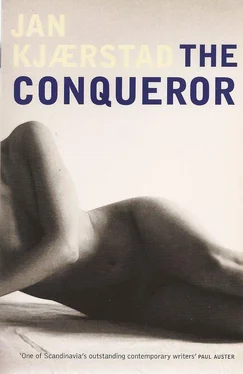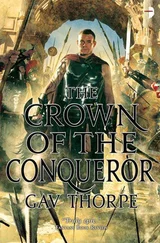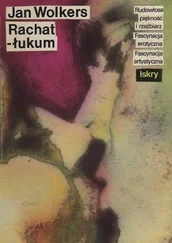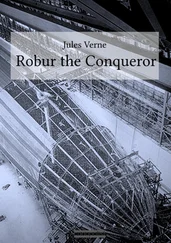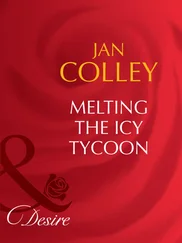The programme on Amundsen opened with a scene from a lecture tour of America in 1907, a hall full of people and Roald Amundsen speaking and presenting a magic lantern show, as it was then known: a Roald Amundsen who clearly did not like doing this but was forced to go on these lucrative tours in order to pay off some of his debts. Jonas Wergeland had endeavoured to capture the atmosphere and the audience’s air of expectancy, remind people of a time when there were still — quite literally — white spots on the map; he shared with the viewers those faded, hand-tinted pictures of Amundsen and his men during their ordeals in that frozen wasteland: excellent photographs by the standards of the day but which, to Jonas Wergeland’s eyes, only made it clear that all they had left of those heroes now were some colourless snaps, and with one of the palest of these he let the light take over completely, turning the picture into dancing ‘snow’, a swirl of dots out of which the outline of a figure gradually emerged — like the picture used to do, back in television’s infancy, when you adjusted the aerial — until eventually the real live Amundsen stood revealed, standing in the polar light at Gjoa Haven in the far north of Canada. The washed-out photograph had been transformed into bright, colourful reality. Amundsen was seen from the side, but it was easy to tell just from that strong profile that his face was glowing with happiness; it was a true magic lantern picture: a magical, light-suffused picture of a man in his own personal paradise.
I must say something about this light; it was of crucial significance to Jonas Wergeland. Not for nothing had he worked so hard on the lighting in his programmes. A lot of people have remarked on Jonas Wergeland’s inventiveness, his technical brilliance and, more than anything, his uniquely charismatic face, but for Jonas himself it all came down to light, to darkness and light. From the moment he started in television he knew that here, in the flickering of the TV screen, he had found, as Amundsen had done in the radiance of the ice, the golden fleece he had always been endeavouring to win: unsuccessfully at first, through music, then the study of the stars, then architecture. To Jonas Wergeland, television was primarily light. He was at all times conscious of the TV screen’s dual function, as a projector of visual images and as a lamp: it often amazed him, when a television was switched on, to see how well it lit up a dark room. Making television programmes was storytelling with light. It was no coincidence that NRK celebrated the screening of the last programme in the series — in December, no less, on the darkest day of the year — with a little, internal, torchlight procession or that one, possibly rather overexcited, individual referred to Jonas Wergeland in a speech of congratulation as a Prometheus, an enlightener, the one who brought fire to mankind. Jonas himself was more modest: ‘All I’ve done is to strike twenty-odd matches in a dark grave,’ he said.
Hence the reason that Jonas dwelled for so long on that picture of Roald Amundsen standing in the glaring light of the frozen wasteland, like a worshipper before a crucifix. Needless to say, Jonas Wergeland never came close to choosing the trek to the South Pole as the central element in his programme. He wanted to focus on another Amundsen, on the skills that were the secret behind the success of the South Pole expedition. Because, the way Jonas saw it, Amundsen was a collector. He did not simply collect artefacts from a foreign culture, though. Above all else, what he collected was knowledge, about everything that could help him to survive the cold. Jonas concentrated, therefore, on Amundsen’s first major expedition, the Gjøa ’s voyage through the North-West Passage, that barrier of ice, and the programme placed little emphasis on the formidable fact that Amundsen and his six men were the first to sail all the way through this passage in one ship; instead it centred on the daily life of the team during the two years they spent in the country around Gjoa Haven, a little bay on King William Island, as they charted hitherto unknown areas and made scientific measurements close to the magnetic North Pole — activities which were as nothing compared to their encounter with the nomadic hunters of the region, an Eskimo tribe called the Netsilik: ‘people of the seal’. In the old days men had dreamed of a shortcut to the East, a hidden passage, possibly up here in the north, and like Columbus discovering America in his attempt to find another route to the East, Amundsen, too, found his New World, namely the world of the Inuit. Amundsen liked it here. He perceived that the Arctic was an enigma, that it harboured mysteries of which we knew little but which presented a challenge to our technological presumption, as an Arctic iceberg would take the Titanic itself by such grimly symbolic surprise.
The Amundsen programme proved to be the most expensive in Jonas Wergeland’s series. For one thing, it was filmed on location, near today’s Gjoa Haven, and late in the winter at that, both in order to film scenes of the harsh winter conditions — they were lucky enough to catch one of the season’s last storms — and to get some shots of the hunting. And for another, Jonas used a lot of the locals as extras and did not stint when it came to props: teams of dogs, Eskimo suits made from reindeer skin and so on. They even built a rough facsimile of the old Gjoa Haven in a bay, with the Villa Magnet, the Uranienborg astronomical observatory, igloos and all — the boat alone was a set: all they needed was the rigging jutting out of the snow like an antenna. It seemed that Jonas Wergeland did not want to spare any expense when it came to the depiction of a Norwegian who had displayed those rare qualities: curiosity, a willingness to learn — and respect for another people.
The programme revolved, in other words, around Amundsen the ethnographer, a man who patiently observed the way of thinking and the way of life in an icebound region: an image which broke with most people’s view of Amundsen as nothing but an adventurer on skis, a ruthless egotist who would walk over anybody to get where he wanted. In Jonas Wergeland’s programme, Amundsen came over as a man who took an enormous interest in his fellow men and had a knack for getting on with people. In scene after scene one was shown how keen Amundsen was to learn tricks which could save a life in extreme weather conditions, how he studied the products of the Eskimos’ inventiveness, everything from the five different items which went to make up their footwear to the technique for checking the quality of the snow; from the difficult art of building an igloo to the way in which, when travelling across hard-packed snow, one should allow a thin layer of ice to form on the runners of the dogsled. These scenes must be among the finest ever shown on a television screen when it comes to depicting life amid the snow and ice, something every Norwegian is certainly in a position to appreciate. But above all else, viewers were shown how Amundsen learned the two lessons which would bring him victory in the race to the South Pole: firstly, how to dress in trousers and anoraks of animal pelts, from the skin out — in other words: no woollen underwear — and leave both the inner and the outer anoraks hanging loosely outside his trousers, to create an insulating layer of air between them and prevent a build-up of sweat; and — secondly — how Amundsen and his men, especially Helmer Hanssen, picked up a lot of new and important tips regarding equipment and techniques for handling dogsleds. They learned one particularly vital lesson: in extreme cold and snow the only thing you could depend on was the dogs. ‘On this expedition Amundsen not only conquered the North-West Passage,’ Jonas Wergeland said, addressing the camera during his regular spot in the programme. ‘He also won an insight into the art of survival. When all is said and done, it was here in the north that he conquered the South Pole.’
Читать дальше
